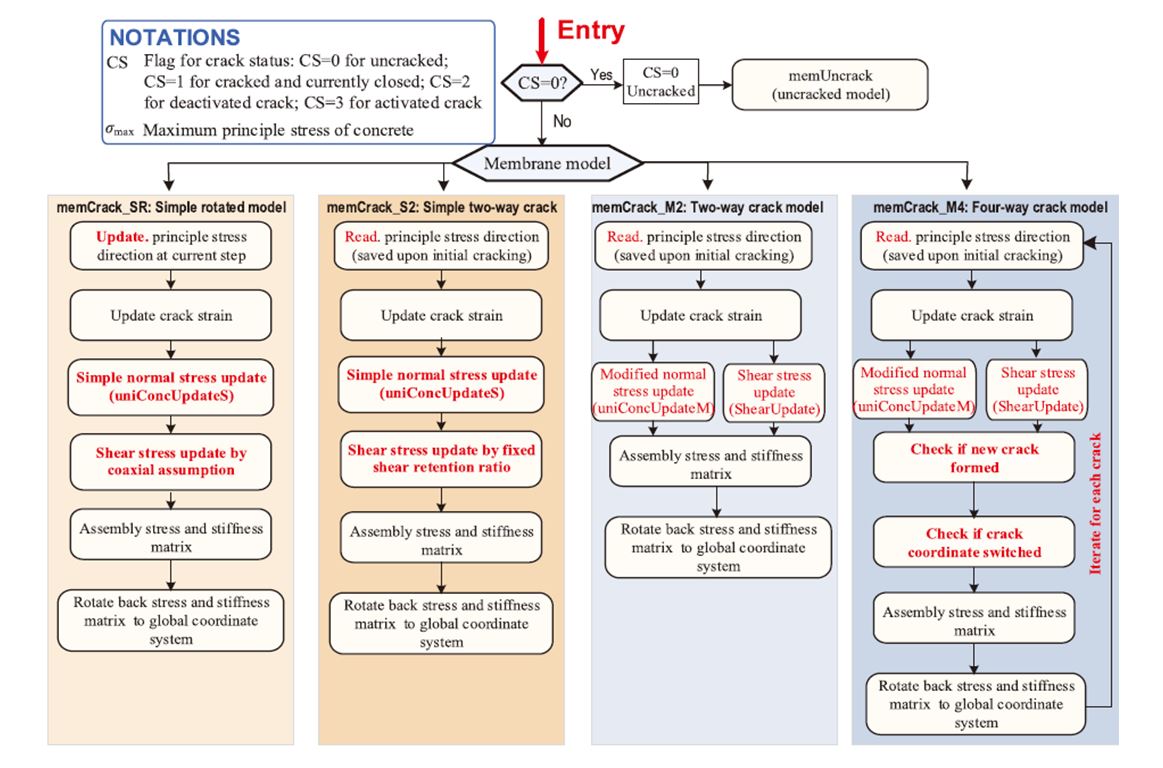Video Article Open Access
Concrete Constitutive Models for Implicit and Explicit Solver
Jia-Ji Wang*, Y.L. Mo
Dept. of Civil and Environmental Engineering, University of Houston, Houston, TX, 77054, USA
Vid. Proc. Adv. Mater., Volume 2, Article ID 2021-02145 (2021)
DOI: 10.5185/vpoam.2021.02145
Publication Date (Web): 30 Mar 2021
Copyright © IAAM
Graphical Abstract

Abstract
A new set of constitutive models is developed for simulating reinforced concrete (RC) and steel-concrete (SC) members in ABAQUS. The developed has reduced mesh sensitivity and is based on the decoupling assumption and the fixed-angle crack assumption in order to consider the pinching effect, confinement, strength degradation, and shear softening of concrete. In the developed biaxial reinforced concrete models, the uniaxial model is first established, and the biaxial model is subsequently assembled from the uniaxial model. First, the proposed uniaxial constitutive model of concrete is reported. The mesh sensitivity of the model is reduced by adjusting the descending branch of the concrete model based on mesh size. Second, a total of five biaxial constitutive models of concrete are reported to cover a wide range of simulation requirements in engineering design. Third, the numerical implementation of the proposed concrete model in both ABAQUS implicit and explicit solvers is discussed. Subsequently, the modified two-way fixed angle crack model is validated by monotonic and hysteretic panel tests. The FE model exhibits little mesh sensitivity when the element number increased from 4 to 400. The developed model accurately predicts the pinching effect and the softening effect of the panels. Finally, many existing tests on RC containment vessels and SC shear walls under lateral loads are simulated, and the modified two-way fixed angle crack model demonstrates adequate accuracy in terms of predicting the initial stiffness, ultimate capacity, and pinching effect. The proposed subroutine package for simulating RC members includes the dominant mechanical behaviours of concrete and can be adopted for high-efficiency simulation of RC and SC structures.
Keywords
Reinforced concrete; constitutive model; finite element; composite structures.
References
- C. Liu, Y. Yang, J.J. Wang, J.S. Fan, M. X. Tao, Y.L. Mo; Engineering Structures, 2020, 219, 110880.
- J. J. Wang, C. Liu, J.S. Fan, J.F. Hajjar, X. Nie; ASCE Journal of Structural Engineering, 2019, 145(9), 04019088.
- J. J. Wang, X. Nie, F.M. Bu, M.X. Tao; Engineering Structures, 2020, 215, 110656.
- J. J. Wang, M. X. Tao, J. S. Fan, F. M. Bu. Engineering Structures, 2019, 197, 109439.
- X. Nie, J. J. Wang, M. X. Tao, J. S. Fan, Y. L. Mo, Z.Y. Zhang; ASCE Journal of Structural Engineering, 2020, 146(5), 04020047.
Biography
Jia-Ji Wang is currently a postdoctoral associate supervised by Dr. Y. L. Mo in Department of Civil and Environmental Engineering at University of Houston. Enthusiastic about applying high-fidelity computational methods in structural analysis and design, Dr. Wang’s research is mainly focused on: (1) High fidelity constitutive models for reinforced concrete and composite structures; (2) Seismic performance and design recommendations of RC shear walls and composite shear walls under complicated load.
Video Proceedings of Advanced Materials

Upcoming Congress



